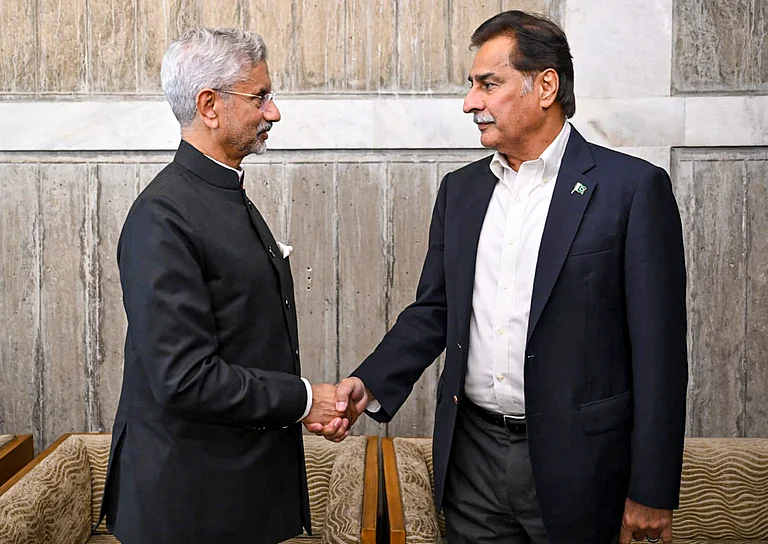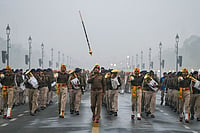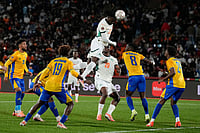
“I stand by what I said (that the thermonuclear test at Pokhran-II was a ‘fizzle’). I won’t say anything more before the dust settles down.”
—K. Santhanam, Former DRDO scientist

“Maybe Santhanam’s conscience pricked him to come out in the open and talk about something that he as a scientist had all along doubted.”
—P.K. Iyengar, Ex-chairman, IAEC

“Either the Indian thermonuclear device failed completely or whatever yield that was recorded was entirely from the boosted fission device.”
—B.K. Subbarao, Ex-Indian navy captain

“The tests were successful. If some of the scientists, who have all been my colleagues, still have doubts, then we’re willing to discuss them.”
—Dr R. Chidambaram, Principal scientific advisor

“India’s doctrine of having a credible nuclear deterrent should not be reduced to a minimum nuclear deterrent.”
—Dr A.N. Prasad, Former BARC director
***
On the scorching afternoon of May 11, 1998, India received the news of three simultaneous nuclear tests, including a thermonuclear device (or an H-bomb), at Pokhran. The celebrations reached a crescendo on May 13 as Indian scientists successfully exploded another two nuclear devices. These tests were perceived as an explosion of national esteem and prestige, the big bangs in the desert of Rajasthan heralding the arrival of an emerging superpower.
Eleven years later, the nostalgia for the summer of 1998 seems to have soured, perhaps even found illusory. Courtesy former Defence Research and Development Organisation scientist K. Santhanam. For, at a seminar organised by the Institute for Defence Studies and Analyses (IDSA) on August 25, Santhanam declared that the thermonuclear test of 1998 was a “fizzle”, that India needed to conduct more tests to master the fusion or H-bomb technology (See Fiction Vs Fact). The implication of his comment was clear—only a mastery over the H-bomb could strengthen India’s claims of possessing a “credible nuclear deterrent”.
Santhanam’s wasn’t a case of gross indiscretion as the IDSA discussions were under London’s Chatham House rules, allowing participants to speak and express their views on the subject under discussion; their views could also be discussed later but without attribution. Santhanam’s comments, however, were reported the following day in the media. Instead of issuing denials, as perhaps most scientists would have under the circumstances, Santhanam repeated his claims about Pokhran-II before the TV cameras as well.
In a way, Santhanam was repeating what a clutch of scientists, both in India and in the West, had said about Pokhran-II in 1998—that the thermonuclear device hadn’t really been a success. But the Indian government and the scientific establishment had dismissed such claims as an outcome of the inevitable heartburn arising from India’s entry into the exclusive league of nations with H-bombs (the US, UK, France, Russia and China). The same charge can’t be levelled against Santhanam, though. He was the field director at Pokhran-II; his organisation was then responsible for instrumentation; the data generated during Pokhran-II was accessible to him. If an insider like him wouldn’t know, then who would?
Alarmed, the bigwigs of the Indian scientific establishment were quick to weigh in, from former president A.P.J. Abdul Kalam to principal scientific advisor to the government, R. Chidambaram. Joining them was Prime Minister Manmohan Singh and national security advisor M.K. Narayanan. They variously described the controversy as needless, saying Pokhran-II had produced the desired results and consequently there was no need to conduct further nuclear tests.
However, it wasn’t enough to stamp out the embers, and the controversy gathered fire. “I stand by what I said,” Santhanam told Outlook, adding, “I don’t want to say anything further before the dust settles down.” Coming out in his support were some heavyweight Indian nuclear scientists, like former chairman of the Indian Atomic Energy Commission, P.K. Iyengar. “Maybe Santhanam’s conscience pricked him to come out in the open and talk about something that he as a scientist had all along doubted,” he told Outlook.
Iyengar, a key member of the Pokhran-I test in 1974, says he has for long doubted the success of the thermonuclear test and even tried to warn the government about premature celebrations. “I had met the BJP leadership in 2000, since the National Democratic Alliance was then in power, and told them that we need more tests to develop the thermonuclear weapon, since the one in May 1998 was not a successful one. But they told me their scientists were satisfied with the results and they were willing to go by their assessment,” Iyengar says.

The lesser crater: Blame it on the Pokhran rocks
Iyengar is not the only sceptic backing Santhanam. There is also the former director of the Bhabha Atomic Research Centre, Dr A.N. Prasad. “India’s doctrine of a credible nuclear deterrent shouldn’t come to mean a minimum nuclear deterrent,” he says. India has to have a nuclear deterrent against both Pakistan and China. Considering China’s mastery over the H-bomb, India can ignore the doubts expressed over the 1998 thermonuclear test at its own peril, Prasad implies.
Following Santhanam’s bombshell at the IDSA seminar, B.K. Subbarao, a former captain in the Indian navy with a PhD in nuclear technology, wrote a letter to Prime Minister Manmohan Singh (copies of which were marked to Sonia Gandhi and Rahul) requesting him to realise “the border between political statements and scientific truths”. He writes further, “I have been systematically explaining the failure of the first hydrogen bomb test of India, with the hope that the prime minister and the nuclear policymakers of our country would refrain from basing their decisions on the unscientific proclamations of senior scientists like Dr R. Chidambaram and Dr Abdul Kalam.”
On his part, R. Chidambaram, a key player in Pokhran-II, stands his ground. “The tests were successful and produced the desired results,” he told Outlook. “If some of the scientists, who have all been my colleagues, still have doubts, then we are willing to discuss it with them.”
So, why has Pokhran-II become controversial?
The three simultaneous nuclear tests India conducted on May 11, 1998, included a thermonuclear device with 45-kt yield, a 15-kt fission device and a 0.2-kt sub-kiloton device (less than 1 kt). The two other tests on May 13 were of 0.5 kt and 0.3 kt devices. Of these five, the controversy is over the thermonuclear device. A hundred to thousand times more powerful than the fission or atom bomb, a fusion bomb has a fission bomb as its trigger, and releases energy called yield, which is calculated from seismic sensor readings.
And therein lies the controversy. To begin with, there were differences in the seismic reading of Indian sensors and Western ones. The official science establishment held that this was because of wave interferences caused by three simultaneous explosions and that waves weaken as they travel long distances. The sceptics counter that such interferences ought to have reflected in the seismic reading of the Indian sensors as well. And while waves do weaken over great distances, this feature is factored in to calculate the seismic reading generated by a thermonuclear test.
Most are in agreement that the thermonuclear device in Pokhran-II registered a seismic reading of 5.2 mb (mb being the body wave magnitude and related roughly to the Richter scale). But the official claim is that the seismic reading was 5.47 mb with a yield of 45 kt. Subbarao, as also Hans Kirstensen of the Federation of American Scientists (See “Not A Fizzle, But Certainly Not What India Claims” ), say that at 5.2 mb, the yield has to be less than 30 kt. “Either the Indian thermonuclear device failed completely, or whatever yield that was recorded was entirely from the boosted fission device,” Subbarao told Outlook. (A boosted fission device is only 10 times more powerful than an atom bomb.)
Subbarao presents another possibility. As he told Outlook, “Alternatively, the thermonuclear device got extinguished midway without burning fully and therefore could not go beyond the 50-kt yield that the Indian scientists claimed.” In other words, the device was configured to provide a far higher yield, but its failure prompted the scientists to claim, as an afterthought, that it had been consciously configured to produce less than 50-kt yield.
Usually, thermonuclear devices are configured to provide extremely high yields. China’s initial H-bomb tests provided a yield well over 1 megatonne. This is why Iyengar says, “The analysis from the (seismic) data showed that the yield was so low that it couldn’t have been a successful thermonuclear test.” Adds Prasad, “The yield has always been a debatable issue.” Pointing out that other countries had had to conduct a number of tests before they could master the H-bomb technology, he says, “It’s highly unlikely that the desired result could be achieved in one shot.” Prasad also cautions that unless the data from the Pokhran-II tests is shared with independent experts in the country, India may be left only with a “minimum credible deterrent”.
Chidambaram, however, says he and a dozen other experts from BARC have tried to clear the sceptics’ doubts through a paper published in the journal Atom for Peace. In the paper, Chidambaram argues that the confusion over Pokhran-II has arisen because of the different methods of calculation adopted by the Indian and some of the international seismic centres. Most global analysis of seismic data on nuclear explosions is based on two seismic magnitudes—the body wave and the surface wave. The former is calculated from compressional seismic waves in the body of the earth and the latter from measurements of surface seismic waves. Those seismologists who preferred surface wave to body wave magnitude in analysing the May 11 tests have come out with data closer to that of the Indians—that is, the yield from Pokhran-II was between 55 kt and 60 kt, of which 12 kt or thereabouts was from the fission bomb used to trigger the thermonuclear device.
Doubts over Pokhran-II have also been expressed because of the nature and shape of the crater formed on May 11. It’s said the May 11 crater was too small to have been created by a thermonuclear device. But Indian official scientists say crater formation depends on the geological condition, and the depth and design of the device. They argue that the Pokhran rocks have “lower cratering” efficiency than, say, the buckboard basalt rock at the Nevada nuclear test site in the US.
The decision to have simultaneous explosions has also been criticised, particularly as it made it difficult for others to judge the efficacy of the thermonuclear test. As Chidambaram notes, “The necessity for the simultaneous detonation of the thermonuclear and the fission device on May 11 was due to the fact that the two shafts where these detonations were carried out were separated by only 1 km. There was a concern that otherwise the shock wave from a detonation in one shaft might damage the second shaft and the equipment located therein.”
Officials in South Block, too, dismiss the need to achieve a yield in megatonnes, saying such high yield is a “relic of the Cold War”. One official says advanced nuclear powers like the US, UK and France have reduced the size of their warheads to less than 450 kt. Additionally, since the Indian security theatre is in South Asia, warheads of megatonnes could have a blowback on Indian cities.
And though the jury is still out on Pokhran-II, a senior Indian diplomat privy to the 1998 tests sums it up quite aptly: “It was neither a fizzle, nor a big bang.”


























